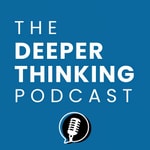The Deeper Thinking Podcast – Détails, épisodes et analyse
Détails du podcast
Informations techniques et générales issues du flux RSS du podcast.

The Deeper Thinking Podcast
The Deeper Thinking Podcast
Fréquence : 1 épisode/2j. Total Éps: 194

Classements récents
Dernières positions dans les classements Apple Podcasts et Spotify.
Apple Podcasts
🇨🇦 Canada - philosophy
05/08/2025#54🇺🇸 États-Unis - philosophy
05/08/2025#33🇨🇦 Canada - philosophy
04/08/2025#38🇬🇧 Grande Bretagne - philosophy
04/08/2025#69🇺🇸 États-Unis - philosophy
04/08/2025#32🇨🇦 Canada - philosophy
03/08/2025#43🇬🇧 Grande Bretagne - philosophy
03/08/2025#46🇺🇸 États-Unis - philosophy
03/08/2025#29🇨🇦 Canada - philosophy
02/08/2025#57🇬🇧 Grande Bretagne - philosophy
02/08/2025#51
Spotify
Aucun classement récent disponible
Liens partagés entre épisodes et podcasts
Liens présents dans les descriptions d'épisodes et autres podcasts les utilisant également.
See all- https://en.wikipedia.org/wiki/Carl_Jung
109 partages
- https://en.wikipedia.org/wiki/Simone_Weil
71 partages
- https://lexfridman.com/podcast/
53 partages
- https://www.youtube.com
605 partages
Qualité et score du flux RSS
Évaluation technique de la qualité et de la structure du flux RSS.
See allScore global : 52%
Historique des publications
Répartition mensuelle des publications d'épisodes au fil des années.
Adam Curtis Unmapped: The Myths We Live By - The Deeper Thinking Podcast
Épisode 9
dimanche 29 septembre 2024 • Durée 06:58
Title: Adam Curtis Unmapped: The Myths We Live By – The Deeper Thinking Podcast
Episode Description:
In this episode of The Deeper Thinking Podcast, we explore the mind of British filmmaker Adam Curtis, as interviewed by Nathalie Olah for Crack Magazine. Curtis dissects the flawed maps we use to navigate a world that’s changing faster than we can understand. From the paralysis of the climate movement to the nostalgia-fueled politics of today, Curtis challenges us to rethink our entire approach to progress, power, and the future.
We explore his critique of technocracy, AI, and our collective obsession with stability in a world that refuses to stay still.
Tune in for a deep dive into the forces molding our world and consider what it truly means to challenge the narrative. If you’re ready to question the status quo, this is an episode you won’t want to miss.
Relevant Hashtags:
📌 General Topics & Themes: #TheDeeperThinkingPodcast #AdamCurtis #CrackMagazine #PhilosophyOfPower #ClimateCrisis #TechnocracyFail #AIcritique #NostalgiaTrap #PoliticalSatire #FutureOfProgress #SystemicChange #PodcastDiscussion #CriticalThinking #ChallengeTheNarrative #RadicalImagination #BeyondTheMap
📌 Named Individuals in Discussion: #AdamCurtis #NathalieOlah #KamalaHarris #KeirStarmer #AlfredKorzybski #AIcritique #Technocracy #BourgeoisGreens #ClimateLeadership
📌 Related Thought Leaders & Philosophers: #NoamChomsky #MichelFoucault #SlavojZizek #NaomiKlein #MarshallMcLuhan #WalterBenjamin #GillesDeleuze #HannahArendt #DavidHarvey #AntonioGramsci
📌 Filmmakers & Cultural Critics: #WernerHerzog #ErrolMorris #ChrisMarker #JeanBaudrillard #MarkFisher #JohnBerger
📌 Political Figures Discussed: #KamalaHarris #KeirStarmer #JoeBiden #RishiSunak #AlexandriaOcasioCortez #BernieSanders #EmmanuelMacron #VladimirPutin #XiJinping
📌 AI & Tech Figures in Context: #ElonMusk #MarkZuckerberg #SamAltman #GeoffreyHinton #YuvalNoahHarari #NickBostrom #ShoshanaZuboff
.
Promotional Text:
Subscribe for more deep-dive episodes.
🎧 Listen on Apple Podcasts, Spotify, YouTube (updated weekly).
🔥 New episodes every week. Engage with us by liking, sharing, and leaving a review—your support keeps us exploring and thinking deeply.
The World of Adam Curtis: A Critical Analysis - The Deeper Thinking Podcast
Épisode 27
samedi 12 octobre 2024 • Durée 30:44
Dive deep into the captivating world of Adam Curtis's documentaries in this critical analysis. From exploring the tension between order and chaos to unraveling the paradoxes of freedom, Curtis's work challenges our perceptions of reality, history, and control. In this video, we delve into his unique cinematic techniques, such as the use of archival footage, dissonant soundtracks, and non-linear storytelling, which bring his thought-provoking themes to life.
📌 Key Topics Covered:
The Illusion of Control: How Curtis portrays leaders and technocrats as trapped in their own systems of manipulation.
The Failure of Utopian Dreams: An examination of Curtis's critique of grand societal visions, from Soviet cybernetics to neoliberalism.
Media and Perception: How advertising and political messaging shape desires, identities, and the blurring of reality and fiction.
Historical Patterns: Curtis’s view of history as cyclical, with recurring patterns that highlight the interconnectedness of events.
If you're intrigued by the complex forces shaping our world or the psychological and political themes that Curtis unpacks, this video will deepen your understanding of his work. It’s perfect for fans of documentaries, social commentary, and those curious about the hidden frameworks that define our collective consciousness.
🔍 Keywords:
Adam Curtis, documentary analysis, societal control, political manipulation, historical cycles, archival footage, media critique, illusion of freedom, non-linear storytelling.
Don’t forget to like, subscribe, and hit the notification bell for more in-depth explorations of groundbreaking documentaries and the minds behind them.
Find us on Spotify, iTunes and YouTube
Running Up That Hill - The Deeper Thinking Podcast
Épisode 33
vendredi 25 octobre 2024 • Durée 07:11
Running Up That Hill: Empathy When You Don't Feel Human
The Deeper Thinking Podcast is digitally narrated
For anyone navigating emotional intensity, neurodivergence, and the cost of deep connection.
How do we keep showing up for others without losing ourselves? This episode explores the cycles of empathy—its vitality, its drain, and its quiet power to heal. We move through the paradoxes of connection and exhaustion, especially in neurodivergent experience, where attunement can feel both sacred and overwhelming. This is a meditation on porousness, care, and the practice of self-compassion as a moral resource—not a luxury.
Anchored in the music of Kate Bush, Joy Division, and Bill Callahan, we reflect on how emotional resilience emerges not from hardening but from staying soft—staying near. We draw on insights from neurodiversity, empathy theory, and the ethics of care to ask: what happens when empathy becomes too much—and how do we return to it without collapse?
This is not a celebration of constant attunement. It’s an honest reckoning with the fatigue of feeling, and a slow reclaiming of inner life when the world becomes too loud. From overstimulation to emotional saturation, we explore how the struggle to stay open also reveals the depth of our humanity.
Reflections
This episode gives language to the invisible labor of empathy. It suggests that survival and sensitivity need not be opposites—and that burnout can be a site of return, not just retreat.
Here are some other reflections that surfaced along the way:
- Empathy isn't just felt—it’s metabolized. And that takes energy.
- Being overwhelmed doesn’t mean we’re failing. It means we’re porous.
- Neurodivergent sensitivity is not fragility. It’s depth with thin skin.
- Self-compassion isn't an escape from others. It’s what lets us return to them intact.
- Feeling too much can be a form of wisdom—one we’re rarely taught how to hold.
- Silence can be restoration. Withdrawal can be sacred pause.
- We don’t repair through more giving. We repair through boundaries that honor the body and the psyche.
- Empathy is not always noble. It can be messy, envious, collapsed—and still real.
- In the end, staying human is harder than it looks. But worth it.
Why Listen?
- Explore the links between empathy, overstimulation, and emotional exhaustion
- Understand the ethical and psychological costs of deep feeling
- Reflect on the music of Bush, Callahan, and Joy Division as emotional cartographies
- Engage with the lived experience of neurodivergent perception and care
Listen On:
Support This Work
If this episode met you where you are, you can support the continuation of the work here ($4) Buy Me a Coffee Thank you.
Bibliography
- Bloom, Paul. Against Empathy. Ecco, 2016.
- Walker, Melanie. Self-Compassion: The Proven Power of Being Kind to Yourself. HarperWave, 2015.
- Baron-Cohen, Simon. The Science of Evil: On Empathy and the Origins of Cruelty. Basic Books, 2012.
Bibliography Relevance
- Paul Bloom: Challenges idealized views of empathy, offering critical nuance.
- Kristin Neff: Offers foundational research on the power and necessity of self-compassion.
- Simon Baron-Cohen: Maps empathy scientifically and explores its dysfunctions and deficits.
Empathy isn’t endless. But when we learn to rest, it can begin again.
#EmpathyFatigue #Neurodiversity #EmotionalExhaustion #KateBush #BillCallahan #JoyDivision #SelfCompassion #MentalHealthMatters #TheDeeperThinkingPodcast #EmotionalResilience #BoundariesAndCare #MusicAndMind
The Telepathy Tapes : Exploring the Mind Beyond the Brain - The Deeper Thinking Podcast
Épisode 42
dimanche 15 décembre 2024 • Durée 10:58
The Edges of Perception: Telepathy, Autism, and the Extended Mind
For anyone willing to consider that consciousness might not end at the skull—and that connection might transcend words.
Can minds reach each other beyond language? In this episode, we explore extraordinary claims from families of non-speaking autistic individuals who describe moments of inexplicable connection: questions answered without words, emotions shared without gesture, and a felt sense of mutual thought. These accounts raise more than eyebrows—they challenge the boundaries of what we assume is possible.
Are these stories the result of coincidence, or do they suggest something more? We explore the tension between skepticism and open inquiry, questioning whether the limits of neuroscience reflect the limits of mind—or merely the limits of our current methods. Alongside William James, David Bohm, and contemporary work on the extended mind, we investigate whether consciousness may, in fact, not be confined to a single brain.
From quantum entanglement to altered states, we ask: what kinds of communication remain invisible to standard models? And if minds can connect in unmeasurable ways, how do we listen without immediately needing to prove?
Reflections
This episode moves along the borderlands of perception, where science meets mystery, and where skepticism need not cancel out curiosity.
Here are some reflections that surfaced along the way:
- Communication doesn’t always arrive through language. Sometimes, it’s felt before it’s heard.
- What we call “unscientific” may simply be what we don’t yet have tools to measure.
- Autism may reveal not a deficit, but an alternative route to knowing.
- Not all real things are repeatable. Not all connections are empirical.
- The mind may not be inside us—it may be between us.
- Belief isn’t always required for wonder. But openness is.
- If we can’t measure love, why do we expect to easily measure telepathy?
- Some truths live in margins—where science, mysticism, and lived experience blur.
Why Listen?
- Engage with firsthand accounts of extraordinary connection among non-speaking autistic individuals
- Explore the overlap of mysticism, neuroscience, and quantum theory
- Challenge the dominant models of cognition and where mind “ends”
- Rethink perception through the lens of William James, David Bohm, and Annie Murphy Paul
Listen On:
Support This Work
If this episode moved you or opened new questions, you can support the ongoing work here: Buy Me a Coffee. Thank you for staying with the questions.
Bibliography
- James, William. The Varieties of Religious Experience. New York: Longmans, Green & Co., 1902.
- Bohm, David. Wholeness and the Implicate Order. London: Routledge, 1980.
- Paul, Annie Murphy. The Extended Mind. Mariner Books, 2021.
- Koch, Christof. Consciousness: Confessions of a Romantic Reductionist. MIT Press, 2012.
- Huxley, Aldous. The Doors of Perception. Harper & Brothers, 1954.
Bibliography Relevance
- William James: Offers early psychological insight into mystical and nonordinary experiences.
- David Bohm: Suggests a quantum model of consciousness and deep interconnectedness.
- Annie Murphy Paul: Proposes a broader view of cognition extending beyond the brain.
- Christof Koch: Bridges neuroscience and the search for subjective consciousness.
- Aldous Huxley: Articulates the limits of ordinary perception and the potential of altered states.
Some forms of connection can’t be proven. That doesn’t mean they aren’t real.
#Telepathy #Autism #ExtendedMind #WilliamJames #DavidBohm #Consciousness #NonSpeakingAutism #MysticalExperience #TheDeeperThinkingPodcast #Neurodiversity #QuantumMind #ListeningBeyondWords #MindAndMatter
Homelessness, Policy, and the Ethics of Shelter - The Deeper Thinking Podcast
Épisode 49
samedi 28 décembre 2024 • Durée 09:57
Homelessness, Policy, and the Ethics of Shelter
The Deeper Thinking Podcast is digitally narrated
For anyone who believes shelter is not a privilege, but a moral baseline of any just society.
Why do wealthy societies fail to house their most vulnerable? In this episode, we examine the UK’s escalating homelessness crisis as a mirror of structural breakdown—where policy failure meets moral failure. This isn’t just a national issue; it reflects a broader malaise across Western democracies where the right to shelter is increasingly treated as optional.
We explore the collapse of social housing, austerity’s long shadow, and the political incentives that reward inaction. Through a lens shaped by public ethics, sociology, and housing policy, we question not just what is broken, but who is being broken by it—and why our collective tolerance for this suffering has become so normalized.
This episode challenges the myth that homelessness is about individual failure. Instead, we frame it as a crisis of social contract—where policy choices betray their most basic obligation: to protect the vulnerable. From local councils to national governance, we trace the systemic neglect that turns housing into a battleground for justice.
Reflections
This episode is a call to conscience. It asks us to consider what kind of society lets this happen—and what kind of society we are willing to build instead.
Here are some reflections that surfaced along the way:
- Homelessness is not an anomaly—it is the clearest reflection of a society’s moral architecture.
- Every statistic on homelessness is a measure of political will—or its absence.
- You can’t solve homelessness without redefining the value of home itself.
- Housing policy is always a justice policy. It reveals whose dignity is prioritized.
- People become homeless for systemic reasons. They stay homeless because of structural neglect.
- Shelter is not charity. It is a civic obligation.
- If we accept homelessness, we accept a society where some lives are disposable.
Why Listen?
- Unpack the UK’s housing crisis in the context of global Western policy failures
- Explore how homelessness reflects systemic injustice, not personal deficit
- Examine the ethical collapse that makes housing insecurity socially tolerable
- Engage with frameworks that reframe housing as a right, not a privilege
Listen On:
Resources
Homelessness is not an anomaly; it is the clearest reflection of a society’s willingness—or refusal—to uphold dignity and justice.
#HomelessnessEpidemic #UKHousingCrisis #PolicyReform #SocialJustice #StructuralChange #HousingAsARight #Shelter #TheGuardian #Crisis #Homelessness
Richard Banduric Isolated Audio - The Deeper Thinking Podcast
Épisode 52
lundi 6 janvier 2025 • Durée 10:04
In this episode of The Deeper Thinking Podcast, we feature an excerpt from Richard Banduric's insightful comments, presented as part of NASA's Convergent Aeronautics Solutions Project in collaboration with Shoshin Works.
For the full transcript, check out the show notes, where you’ll also find a link to the source: Episode 69 of the Ecosystems Futures Podcast.
Source Material
Summary Episode
https://www.podbean.com/eas/pb-m8kab-17983d0
Full Transcript
So, I'm the CEO of Field Propulsion Technologies. My background is in electrical engineering and mathematics, and 40 years ago, I was involved in a company, as part owner, that used to do reverse engineering. One of the things that came out of there was some of the NGOs that were trying to reverse-engineer advanced technologies pinged us to look at some of the stuff they had. That got me really curious because this stuff was definitely way more advanced than what we actually had.
One of the things that happened is I ended up getting pulled into classified programs, and there, one of the things I wanted to look at was to see if the US government was actually using these technologies. It turned out that my conclusion was the US government was not. From there, I ended up working in a number of different companies. I had a project with DARPA for a while, and what we were trying to do was explore some of the things we observed, such as longitudinal forces inside composite conductors. These composite conductors weren’t actually conductors; they were something in between a conductor and an insulator and were usually very complex structures.
Some of the things we explored involved using very small particles that were closely spaced. When an accelerated charge moved from particle to particle, we could generate an external or very large force. That was similar to what Ankar is working on; he’s seen the same effect when charges accelerate over a very short distance, generating external force. Our application that we pitched to the NSF, which we worked on with Hannah, was that we could probably use these forces for propulsion. In our case, we’re not using a large capacitor disc but rather very small nanoparticles. Then, the charges accelerate inside the particles and tunnel to the next particle. We are now under Phase Two.
Some other materials we looked at had strange properties, similar to what Hal is doing. If some of these materials, built similarly, were set up not as long thin antennas but as cylinders, they could provide a significant amount of area. In electromagnetics, something called "gauges" indicates there’s no radiation coming out of the ends of an antenna. In our case, we’re pretty sure—based on some experiments we conducted—that what comes out of the ends of an antenna isn’t absolutely nothing or just potentials. If you had an antenna of the right length, you could actually see an electric field associated with these potentials. Instead of using an electromagnetic squid to detect these potentials, we could follow this potential using an electric field meter.
This observation came out of work with these NGOs. Near some of these crafts, electronics would always shut down, and measurements indicated there was an electric field associated with these types of radiation. That’s where my work has gone today. We’ve talked to the Air Force, and we think we could replicate these types of effects. One key observation is that some kind of radiation does come out of the ends of an antenna, which we suspect is longitudinal radiation. Having an electric field and an oscillating scalar potential implies there might be another field out there we can’t currently measure. The Air Force wanted us to investigate this field, which seems similar to effects Chance observed. We assume this field might exert pressure on objects or cause measurable changes, such as in diffraction patterns.
Much of our research confirms what others are working on. For the NSF, our objective is to use these new metamaterials to generate an external force. When we apply a DC current to these materials, we observe accelerated charges in the nanocomponents, producing large forces. These materials, though high-impedance, require relatively low currents but high voltages.
Regarding Larry, some of the places I’ve been and the NGOs I worked with did get data similar to what you’re looking for. However, when I analyzed it, I didn’t see anything like nitrogen. The NGOs I worked with were trying to figure out how large crafts, often triangular, could disappear instantly. Observations suggested these crafts took the image of whatever was behind them and projected it in front, likely by bending light around the triangle. Our conclusion was they achieved this effect with significantly less energy than expected. Sometimes what they projected wasn’t exactly what was behind them, making it possible to track them based on these discrepancies.
The NGOs appeared intent on preventing reverse engineering by incorporating mechanisms to disintegrate their materials. For example, many materials were "smart materials." When analyzed, they turned to dust within minutes. Isotropic analysis of the dust often revealed extraterrestrial origins. These materials were centuries ahead of us, composed of small particles that appeared to communicate and reconfigure themselves. Some materials demonstrated cloaking abilities, blending into the environment, or self-repair. Broken samples occasionally became available, allowing us to conduct experiments.
For example, one experiment involved placing a material on a surface heated to 3,000°F. The material cooled the surface around it, and after being removed and weighed, its mass had reduced. These observations strongly suggest extraterrestrial origin. Some materials were computationally functional, communicating with neighbors and reprogramming themselves. They could reconfigure their properties based on their environment.
These findings imply a level of manipulation of our species by advanced groups. Though rare, these materials can still be found by those who know where to look. They demonstrate extraordinary functions, far beyond human technology. With continued research, I believe we are on the verge of developing transformative new technologies, particularly in propulsion. Within five to ten years, these advancements could significantly change the world.
1. Field Propulsion Technologies
A company focusing on innovative propulsion methods and advanced materials research. Similar technologies are often explored in advanced aerospace and engineering contexts.
2. DARPA (Defense Advanced Research Projects Agency)
A research and development agency of the U.S. Department of Defense responsible for emerging technologies, such as advanced propulsion and materials.
Reference: www.darpa.mil
3. NSF (National Science Foundation)
A U.S. government agency that funds scientific research, including projects exploring advanced materials and propulsion technologies.
Reference: www.nsf.gov
4. Composite Conductors
Engineered materials combining properties of conductors and insulators, often used in advanced applications requiring unique electrical properties.
Reference: IEEE research papers on composite materials.
5. Nanoparticles
Particles at the nanometer scale (1-100 nm) used in materials science for their unique electrical, optical, and structural properties.
Reference: "Nanoparticles: Properties, Applications, and Toxicities" (Materials Science Journal, 2022).
6. Longitudinal Forces in Conductors
Forces observed in advanced materials where charge acceleration leads to directional effects. This is less common in classical physics but studied in advanced electromagnetics.
Reference: Jackson, J.D. "Classical Electrodynamics" (Wiley, 1998).
7. Electroscalar Radiation
A hypothesized type of radiation without traditional electromagnetic fields. It has been proposed in theoretical physics to explain unexplained phenomena.
Reference: Bearden, T. "Scalar Electromagnetics" (1993).
8. Metamaterials
Artificially engineered materials with properties not found in nature, such as negative refractive index or cloaking capabilities.
Reference: Smith, D.R., et al. "Electromagnetic Metamaterials" (Physics Today, 2004).
9. Cloaking Technology (Light Bending)
Theoretical and experimental work on bending light around an object to render it invisible. This aligns with concepts in metamaterials and optics.
Reference: Pendry, J.B., et al. "Controlling Electromagnetic Fields" (Science, 2006).
10. Smart Materials
Materials that can adapt, self-repair, or change properties in response to their environment. Examples include shape-memory alloys and self-healing composites.
Reference: "Smart Materials and Structures" (Journal of Materials Research, 2020).
11. Isotropic Analysis
A technique in materials science used to study isotopic composition, often applied to identify extraterrestrial origins of materials.
Reference: Mass Spectrometry textbooks or journals.
12. Triangular Craft
Commonly reported unidentified flying objects (UFOs) often described as triangular. Hypotheses include advanced propulsion and cloaking technologies.
Reference: "UFOs: Generals, Pilots, and Government Officials Go on the Record" by Leslie Kean.
13. Scalar Potentials
A concept in electromagnetics describing the potential energy field from which electric fields are derived.
Reference: Griffiths, D.J. "Introduction to Electrodynamics" (Pearson, 2017).
14. Extraterrestrial Materials
Materials speculated to originate from non-terrestrial sources, often studied for unique isotopic compositions or properties.
Reference: "The Extraterrestrial Hypothesis in Modern Astrophysics" (Astrophysics and Space Science, 2021).
15. Advanced Propulsion Systems
Propulsion systems utilizing non-traditional methods, including ion propulsion, electromagnetic drives, and plasma-based systems.
Reference: Sutton, G.P., "Rocket Propulsion Elements" (Wiley, 2016).
The AI J Curve: Understanding the Exponential Growth of Artificial Intelligence - The Deeper Thinking Podcast
Épisode 56
dimanche 12 janvier 2025 • Durée 16:14
In this episode, we dive into the concept of the AI J Curve—a powerful metaphor for understanding how artificial intelligence is evolving at an exponential rate. Just like a J-curve, AI development is initially slow but will soon experience a rapid upward trajectory that could transform our world. We break down how this exponential growth is changing industries, society, and even how we interact with technology.
What We Discuss:🚀 The Power of the AI J Curve What exactly is the AI J Curve? We explain the early stages of AI progress and how it leads to a steep upward trajectory. Discover how AI's evolution might feel slow at first but is now accelerating rapidly in ways that could dramatically reshape the future.
⚡ Exponential Growth in AI Unlike gradual technological advancements of the past, AI is experiencing breakthroughs that build on one another, leading to rapid and transformative changes. We explore how these exponential jumps are unfolding and what they mean for the industries involved.
💡 Breakthroughs and Cascading Progress AI is no longer just moving incrementally. With each new discovery, it accelerates the pace of development, creating a cascading effect. We discuss the pivotal moments and innovations that will drive AI toward becoming a dominant force in technology.
🌍 Impact on Society and Industries From healthcare to finance and education, AI’s rapid growth is beginning to disrupt multiple industries. We discuss the effects on the job market, human-AI collaboration, and the new opportunities that arise from this exponential growth.
💬 Stay Ahead of the Curve! Don’t miss out on understanding the accelerating rise of AI. In this episode, we break down the AI J Curve and how its rapid growth will impact the future. Whether you're a tech enthusiast or someone curious about AI's role in the future, this podcast is for you.
#AI #AIJCurve #ExponentialGrowth #ArtificialIntelligence #TechInnovation #FutureOfAI #AIImpact #MachineLearning #AIRevolution #DigitalTransformation #AI2025
🎧 Subscribe, rate, and share if you found this episode insightful!
Subscribe for more deep-dive episodes.
🎧 Listen on Apple Music, Spotify, YouTube.
🔥 New episodes every week. Engage with us by liking, sharing, and leaving a review—your support keeps us exploring and thinking deeply.
What Shapes Us. - The Deeper Thinking Podcast
Épisode 59
mercredi 15 janvier 2025 • Durée 05:40
This episode of The Deeper Thinking Podcast presents a compelling analysis of two increasingly significant forces—Artificial Intelligence (AI) and Unidentified Anomalous Phenomena (UAPs)—as catalysts for exploring humanity’s place in the world. Through a nuanced discussion, the episode bridges personal introspection and societal reflection, offering listeners a thoughtful examination of how external factors can reshape our understanding of what it means to be human.
#AI #UAP #ArtificialIntelligence #UnidentifiedPhenomena #FutureOfHumanity #DeeperThinkingPodcast #PhilosophyAndTechnology #CosmicMysteries #HumanConsciousness #SocietalReflection #TechAndMystery #AIImpact #UAPDiscussion #PodcastEpisode #ExploringTheUnknown
Subscribe for more deep-dive episodes.
🎧 Listen on Apple Music, Spotify, YouTube.
🔥 New episodes every week. Engage with us by liking, sharing, and leaving a review—your support keeps us exploring and thinking deeply.
Wired for Justice - The Deeper Thinking Podcast
Épisode 61
vendredi 17 janvier 2025 • Durée 08:02
Is free will an illusion, or is there still room for choice within the forces that shape us? In this episode, we explore the intersection of determinism, justice, and personal agency—unpacking how neurodivergence, particularly ADHD, influences the urgency to act. From childhood acts of defiance to an unshakable sense of fairness, the discussion moves beyond philosophy into lived experience. Whether freedom is something we command or something we navigate, the decisions we make still carry weight.
Subscribe for more deep-dive episodes.
🎧 Listen on Apple Music, Spotify YouTube.
🔥 New episodes every week. Engage with us by liking, sharing, and leaving a review—your support keeps us exploring and thinking deeply.
#Neurodiversity #ADHD #FreeWill #Justice #Philosophy #Determinism #PersonalGrowth #Mindset #Freedom #Psychology #Ethics #SelfAwareness #Motivation #WiredForJustice #Courage #Agency
The Evolution of Work: Power, Control, and the Remote Revolution - The Deeper Thinking Podcast
Épisode 70
lundi 20 janvier 2025 • Durée 10:34
How did we get here, and where are we going? The shift to remote work is more than just a logistical change—it’s a battle over power, autonomy, and the very nature of labor itself. In this episode of The Deeper Thinking Podcast, we explore the historical forces that shaped the modern office, the cultural and economic tensions driving the pushback against remote work, and the broader implications for workers, businesses, and society. As we navigate this evolving landscape, one question remains: who will shape the future of work?
#FutureOfWork #RemoteWork #WorkplaceEvolution #DigitalNomad #HybridWork #WorkFromAnywhere #LaborRights #EconomicShift #OfficeCulture #WorkLifeBalance #Productivity #TechnologyAndWork #TheDeeperThinkingPodcast
Subscribe for more deep-dive episodes.
🎧 Listen on Apple Music, Spotify, YouTube.
🔥 New episodes every week. Engage with us by liking, sharing, and leaving a review—your support keeps us exploring and thinking deeply.









